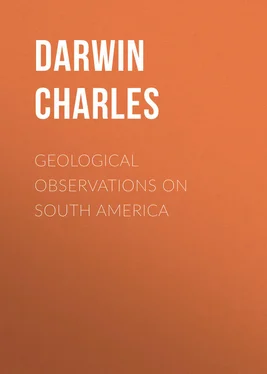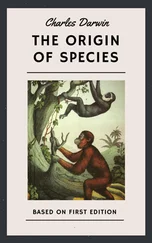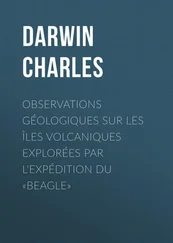Charles Darwin - Geological Observations on South America
Здесь есть возможность читать онлайн «Charles Darwin - Geological Observations on South America» — ознакомительный отрывок электронной книги совершенно бесплатно, а после прочтения отрывка купить полную версию. В некоторых случаях можно слушать аудио, скачать через торрент в формате fb2 и присутствует краткое содержание. Жанр: foreign_antique, foreign_prose, на английском языке. Описание произведения, (предисловие) а так же отзывы посетителей доступны на портале библиотеки ЛибКат.
- Название:Geological Observations on South America
- Автор:
- Жанр:
- Год:неизвестен
- ISBN:нет данных
- Рейтинг книги:3 / 5. Голосов: 1
-
Избранное:Добавить в избранное
- Отзывы:
-
Ваша оценка:
- 60
- 1
- 2
- 3
- 4
- 5
Geological Observations on South America: краткое содержание, описание и аннотация
Предлагаем к чтению аннотацию, описание, краткое содержание или предисловие (зависит от того, что написал сам автор книги «Geological Observations on South America»). Если вы не нашли необходимую информацию о книге — напишите в комментариях, мы постараемся отыскать её.
Geological Observations on South America — читать онлайн ознакомительный отрывок
Ниже представлен текст книги, разбитый по страницам. Система сохранения места последней прочитанной страницы, позволяет с удобством читать онлайн бесплатно книгу «Geological Observations on South America», без необходимости каждый раз заново искать на чём Вы остановились. Поставьте закладку, и сможете в любой момент перейти на страницу, на которой закончили чтение.
Интервал:
Закладка:
Charles Darwin
Geological Observations on South America
CRITICAL INTRODUCTION
Of the remarkable "trilogy" constituted by Darwin's writings which deal with the geology of the "Beagle," the member which has perhaps attracted least attention, up to the present time is that which treats of the geology of South America. The actual writing of this book appears to have occupied Darwin a shorter period than either of the other volumes of the series; his diary records that the work was accomplished within ten months, namely, between July 1844 and April 1845; but the book was not actually issued till late in the year following, the preface bearing the date "September 1846." Altogether, as Darwin informs us in his "Autobiography," the geological books "consumed four and a half years' steady work," most of the remainder of the ten years that elapsed between the return of the "Beagle," and the completion of his geological books being, it is sad to relate, "lost through illness!"
Concerning the "Geological Observations on South America," Darwin wrote to his friend Lyell, as follows: – "My volume will be about 240 pages, dreadfully dull, yet much condensed. I think whenever you have time to look through it, you will think the collection of facts on the elevation of the land and on the formation of terraces pretty good."
"Much condensed" is the verdict that everyone must endorse, on rising from the perusal of this remarkable book; but by no means "dull." The three and a half years from April 1832 to September 1835, were spent by Darwin in South America, and were devoted to continuous scientific work; the problems he dealt with were either purely geological or those which constitute the borderland between the geological and biological sciences. It is impossible to read the journal which he kept during this time without being impressed by the conviction that it contains all the germs of thought which afterwards developed into the "Origin of Species." But it is equally evident that after his return to England, biological speculations gradually began to exercise a more exclusive sway over Darwin's mind, and tended to dispossess geology, which during the actual period of the voyage certainly engrossed most of his time and attention. The wonderful series of observations made during those three and a half years in South America could scarcely be done justice to, in the 240 pages devoted to their exposition. That he executed the work of preparing the book on South America in somewhat the manner of a task, is shown by many references in his letters. Writing to Sir Joseph Hooker in 1845, he says, "I hope this next summer to finish my South American Geology, then to get out a little Zoology, and HURRAH FOR MY SPECIES WORK!"
It would seem that the feeling of disappointment, which Darwin so often experienced in comparing a book when completed, with the observations and speculations which had inspired it, was more keenly felt in the case of his volume on South America than any other. To one friend he writes, "I have of late been slaving extra hard, to the great discomfiture of wretched digestive organs, at South America, and thank all the fates, I have done three-fourths of it. Writing plain English grows with me more and more difficult, and never attainable. As for your pretending that you will read anything so dull as my pure geological descriptions, lay not such a flattering unction on my soul, for it is incredible." To another friend he writes, "You do not know what you threaten when you propose to read it – it is purely geological. I said to my brother, 'You will of course read it,' and his answer was, 'Upon my life, I would sooner even buy it.'"
In spite of these disparaging remarks, however, we are strongly inclined to believe that this book, despised by its author, and neglected by his contemporaries, will in the end be admitted to be one of Darwin's chief titles to fame. It is, perhaps, an unfortunate circumstance that the great success which he attained in biology by the publication of the "Origin of Species" has, to some extent, overshadowed the fact that Darwin's claims as a geologist, are of the very highest order. It is not too much to say that, had Darwin not been a geologist, the "Origin of Species" could never have been written by him. But apart from those geological questions, which have an important bearing on biological thought and speculation, such as the proofs of imperfection in the geological record, the relations of the later tertiary faunas to the recent ones in the same areas, and the apparent intermingling of types belonging to distant geological epochs, when we study the palaeontology of remote districts, – there are other purely geological problems, upon which the contributions made by Darwin are of the very highest value. I believe that the verdict of the historians of science will be that if Darwin had not taken a foremost place among the biologists of this century, his position as a geologist would have been an almost equally commanding one.
But in the case of Darwin's principal geological work – that relating to the origin of the crystalline schists, – geologists were not at the time prepared to receive his revolutionary teachings. The influence of powerful authority was long exercised, indeed, to stifle his teaching, and only now, when this unfortunate opposition has disappeared, is the true nature and importance of Darwin's purely geological work beginning to be recognised.
The two first chapters of the "Geological Observations on South America," deal with the proofs which exist of great, but frequently interrupted, movements of elevation during very recent geological times. In connection with this subject, Darwin's particular attention was directed to the relations between the great earthquakes of South America – of some of which he had impressive experience – and the permanent changes of elevation which were taking place. He was much struck by the rapidity with which the evidence of such great earth movements is frequently obliterated; and especially with the remarkable way in which the action of rain-water, percolating through deposits on the earth's surface, removes all traces of shells and other calcareous organisms. It was these considerations which were the parents of the generalisation that a palaeontological record can only be preserved during those periods in which long-continued slow subsidence is going on. This in turn, led to the still wider and more suggestive conclusion that the geological record as a whole is, and never can be more than, a series of more or less isolated fragments. The recognition of this important fact constitutes the keystone to any theory of evolution which seeks to find a basis in the actual study of the types of life that have formerly inhabited our globe.
In his third chapter, Darwin gives a number of interesting facts, collected during his visits to the plains and valleys of Chili, which bear on the question of the origin of saliferous deposits – the accumulation of salt, gypsum, and nitrate of soda. This is a problem that has excited much discussion among geologists, and which, in spite of many valuable observations, still remains to a great extent very obscure. Among the important considerations insisted upon by Darwin is that relating to the absence of marine shells in beds associated with such deposits. He justly argues that if the strata were formed in shallow waters, and then exposed by upheaval to subaerial action, all shells and other calcareous organisms would be removed by solution.
Following Lyell's method, Darwin proceeds from the study of deposits now being accumulated on the earth's surface, to those which have been formed during the more recent periods of the geological history.
His account of the great Pampean formation, with its wonderful mammalian remains – Mastodon, Toxodon, Scelidotherium, Macrauchenia, Megatherium, Megalonyx, Mylodon, and Glyptodon – this full of interest. His discovery of the remains of a true Equus afforded a remarkable confirmation of the fact-already made out in North America – that species of horse had existed and become extinct in the New World, before their introduction by the Spaniards in the sixteenth century. Fully perceiving the importance of the microscope in studying the nature and origin of such deposits as those of the Pampas, Darwin submitted many of his specimens both to Dr. Carpenter in this country, and to Professor Ehrenberg in Berlin. Many very important notes on the microscopic organisms contained in the formation will be found scattered through the chapter.
Читать дальшеИнтервал:
Закладка:
Похожие книги на «Geological Observations on South America»
Представляем Вашему вниманию похожие книги на «Geological Observations on South America» списком для выбора. Мы отобрали схожую по названию и смыслу литературу в надежде предоставить читателям больше вариантов отыскать новые, интересные, ещё непрочитанные произведения.
Обсуждение, отзывы о книге «Geological Observations on South America» и просто собственные мнения читателей. Оставьте ваши комментарии, напишите, что Вы думаете о произведении, его смысле или главных героях. Укажите что конкретно понравилось, а что нет, и почему Вы так считаете.












